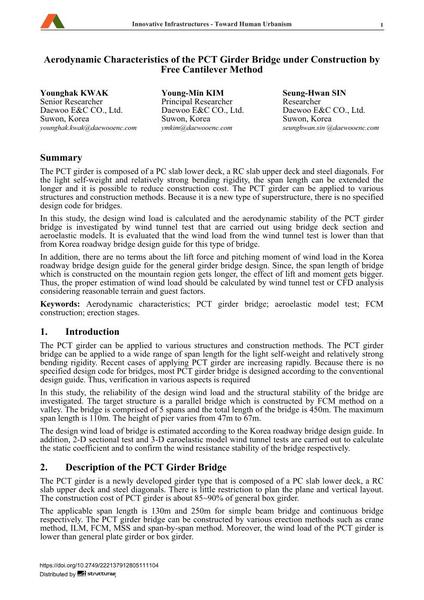Aerodynamic Characteristics of the PCT Girder Bridge under Construction by Free Cantilever Method

|
|
|||||||||||
Bibliographic Details
| Author(s): |
Younghak Kwak
Young-Min Kim Seung-Hwan Sin |
||||
|---|---|---|---|---|---|
| Medium: | conference paper | ||||
| Language(s): | English | ||||
| Conference: | 18th IABSE Congress: Innovative Infrastructures – Towards Human Urbanism, Seoul, Korea, 19-21 September 2012 | ||||
| Published in: | IABSE Congress Seoul 2012 | ||||
|
|||||
| Page(s): | 779-786 | ||||
| Total no. of pages: | 8 | ||||
| DOI: | 10.2749/222137912805111104 | ||||
| Abstract: |
The PCT girder is composed of a PC slab lower deck, a RC slab upper deck and steel diagonals. For the light self-weight and relatively strong bending rigidity, the span length can be extended the longer and it is possible to reduce construction cost. The PCT girder can be applied to various structures and construction methods. Because it is a new type of superstructure, there is no specified design code for bridges. In this study, the design wind load is calculated and the aerodynamic stability of the PCT girder bridge is investigated by wind tunnel test that are carried out using bridge deck section and aeroelastic models. It is evaluated that the wind load from the wind tunnel test is lower than that from Korea roadway bridge design guide for this type of bridge. In addition, there are no terms about the lift force and pitching moment of wind load in the Korea roadway bridge design guide for the general girder bridge design. Since, the span length of bridge which is constructed on the mountain region gets longer, the effect of lift and moment gets bigger. Thus, the proper estimation of wind load should be calculated by wind tunnel test or CFD analysis considering reasonable terrain and guest factors. |
||||
| Keywords: |
erection stages aerodynamic characteristics PCT girder bridge aeroelastic model test FCM construction
|
||||
